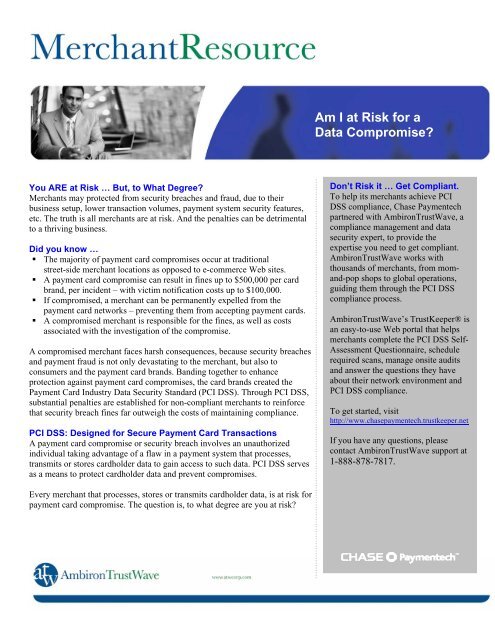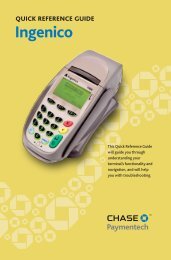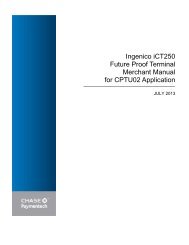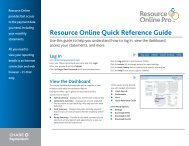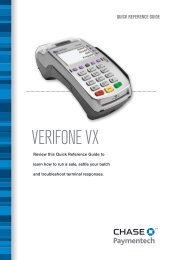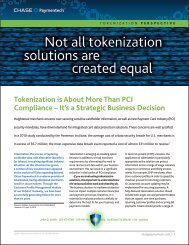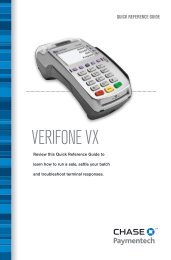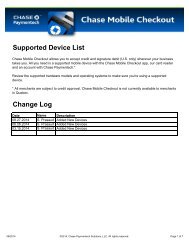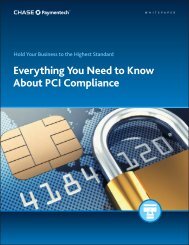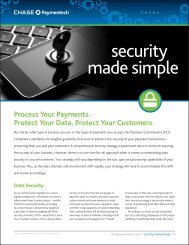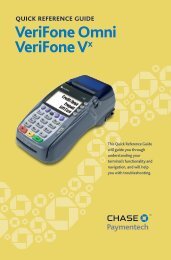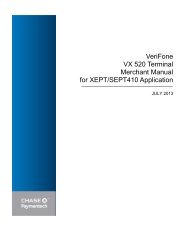Am I At Risk? - Chase Paymentech
Am I At Risk? - Chase Paymentech
Am I At Risk? - Chase Paymentech
- No tags were found...
Create successful ePaper yourself
Turn your PDF publications into a flip-book with our unique Google optimized e-Paper software.
<strong>Am</strong> I at <strong>Risk</strong> for aData Compromise?You ARE at <strong>Risk</strong> … But, to What Degree?Merchants may protected from security breaches and fraud, due to theirbusiness setup, lower transaction volumes, payment system security features,etc. The truth is all merchants are at risk. And the penalties can be detrimentalto a thriving business.Did you know …• The majority of payment card compromises occur at traditionalstreet-side merchant locations as opposed to e-commerce Web sites.• A payment card compromise can result in fines up to $500,000 per cardbrand, per incident – with victim notification costs up to $100,000.• If compromised, a merchant can be permanently expelled from thepayment card networks – preventing them from accepting payment cards.• A compromised merchant is responsible for the fines, as well as costsassociated with the investigation of the compromise.A compromised merchant faces harsh consequences, because security breachesand payment fraud is not only devastating to the merchant, but also toconsumers and the payment card brands. Banding together to enhanceprotection against payment card compromises, the card brands created thePayment Card Industry Data Security Standard (PCI DSS). Through PCI DSS,substantial penalties are established for non-compliant merchants to reinforcethat security breach fines far outweigh the costs of maintaining compliance.PCI DSS: Designed for Secure Payment Card TransactionsA payment card compromise or security breach involves an unauthorizedindividual taking advantage of a flaw in a payment system that processes,transmits or stores cardholder data to gain access to such data. PCI DSS servesas a means to protect cardholder data and prevent compromises.Don’t <strong>Risk</strong> it … Get Compliant.To help its merchants achieve PCIDSS compliance, <strong>Chase</strong> <strong>Paymentech</strong>partnered with <strong>Am</strong>bironTrustWave, acompliance management and datasecurity expert, to provide theexpertise you need to get compliant.<strong>Am</strong>bironTrustWave works withthousands of merchants, from momand-popshops to global operations,guiding them through the PCI DSScompliance process.<strong>Am</strong>bironTrustWave’s TrustKeeper® isan easy-to-use Web portal that helpsmerchants complete the PCI DSS Self-Assessment Questionnaire, schedulerequired scans, manage onsite auditsand answer the questions they haveabout their network environment andPCI DSS compliance.To get started, visithttp://www.chasepaymentech.trustkeeper.netIf you have any questions, pleasecontact <strong>Am</strong>bironTrustWave support at1-888-878-7817.Every merchant that processes, stores or transmits cardholder data, is at risk forpayment card compromise. The question is, to what degree are you at risk?
Key QuestionsAnswering the following merchant questions will help you begin to understand the risk level your business faces, in regards topayment card compromise:• Is a Point of Sale (POS) device, terminal or computer used for face-to-face, card present transactions atyour facility?o Each of these types of payment acceptance methods presents unique risks to a merchant’s environment.• Is your payment acceptance application on Visa’s list of validated payment applications, which have all beenapproved under Visa’s Payment Application Best Practices (PABP)?o Choose a service provider listed on either Visa’s or MasterCard’s list of PCI DSS compliant service providers(Note: Not one of the 170 compromised merchants investigated by <strong>Am</strong>bironTrustWave used a paymentapplication that listed with Visa’s PABP). Check your application’s compliance at the following links:• Visa: http://www.visa.com/cisp• MasterCard: https://sdp.mastercardintl.com• If a POS device is used, does it connect to a telephone line, private network (leased line or frame relay) or Ethernetnetwork (i.e., DSL or Cable Modem)?o 21 percent of compromises occur through telephone line or dial-up connectionso 30 percent of compromises occur through T1 or leased-line connectionso 49 percent of compromises occur through DSL or cable modem connections• Do you store any cardholder data electronically, whether it is collected face-to-face, via the Internet, or by mail orphone orders?o 80 percent of compromised merchants do not protect stored data.PCI Compliance: A Merchant’s Best ProtectionA merchant can’t afford not to comply with the PCI DSS. PCI DSS is a robust and protects against attack methods used bycyber criminals today. According to a thorough analysis of more than 170 payment card breach investigations conducted by<strong>Am</strong>bironTrustWave’s data security experts, the top ten methods of compromise are:1. Backdoor/Trojan2. No Firewall3. Password Brute Force4. Remote Access5. SQL Injection6. Internal Theft7. Remote Buffer Overflow8. FTP Access to Data9. Remote Exploit10. Wireless ExploitMost of these are complex hacking techniques that require an IT security expert to develop a protection plan against;therefore, the card associations require that merchants submit quarterly vulnerability scans conducted by an approvedscanning vendor to ensure PCI compliance. Scans prod a network-environment for vulnerabilities that can allow a hacker toutilize one of the methods above to compromise a merchant’s network.


